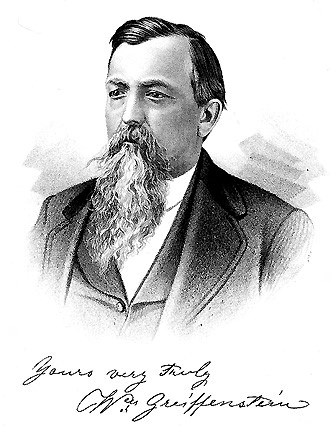
(Photo courtesy of the Kansas Historical Society) Orsemus Hills Bentley's book History of Wichita and Sedgwick County, Kansas: Past and Present, states: "William Greiffenstein was a warm-hearted, generous man, and in Sedgwick County, his friends are legion. Time will do his memory justice, and posterity will perpetuate his many virtues." Greiffenstein married twice, his first wife was Cheyenne Jennie who died in 1868; his second wife was Catherine Barnett, daughter of Pottawatomie Chief Abram Barnett; and he was widely respected for his fair dealings with the Cheyenne, Arapaho, Kiowa, Comanche and Apache people. In 1867, he established a trading post near Fort Cobb and the Anadarko Indian Agency. Once established he was able with the help of his wife, Cheyenne Jennie, to recover several white children from various American Indian tribes that were held captive, returning them their parents. November 7, 1868, Greiffenstein’s employee, Cheyenne Jack, notice a white woman at Yellow Bear’s Arapaho camp while trading with the Indians. He was able to give this woman a pencil and paper to write a note that he carried back to Fort Cobb. It was given to Dutch Bill on November 25. The note read: “Kind Friend, In 1869, General Philip Sheridan accused Greiffenstein of selling guns to the Indians, though technically he was authorized by the Bureau of Indian Affairs to sell guns to them, and was expelled from the Indian Territory. Greiffenstein denied the charges, and later was compensated by the government for all his lost goods. In 1869, he married Catherine Barnett. In 1870, he assisted in the founding of the city of Wichita, Kansas. He opened a store, and was mayor of the town in 1878, and from 1880 to 1884. He also founded the town of Burnett, Indian Territory in 1888. He died September 26, 1899 in Burnett.
Jerome A. Greene. Washita: The U.S. Army and the Southern Cheyenne, 1867-1869. Richard G. Hardorff. Washita Memories: Eyewitness Views of Custer's Attack on Black Kettle's Village. Thom Hatch. Black Kettle, the Cheyenne Chief Who Sought Peace but Found War. Stan Hoig. The Battle of the Washita. George E. Hyde. Life of George Bent. |
Last updated: August 7, 2020
